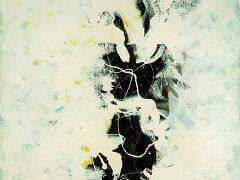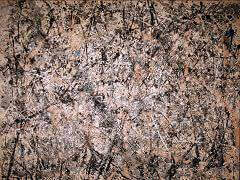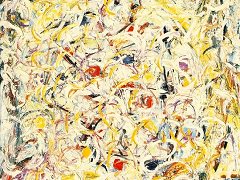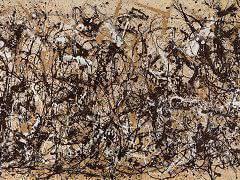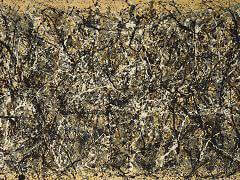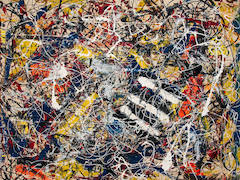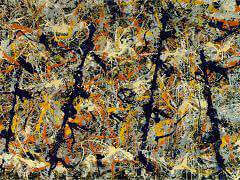Greyed Rainbow, 1953 by Jackson Pollock
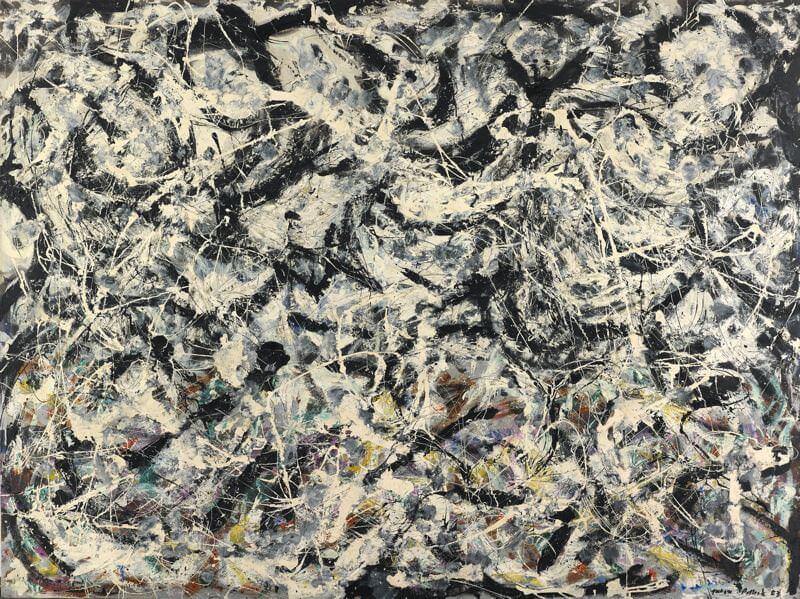
In Greyed Rainbow, Jackson Pollock created an extremely unique and ornate visual expanse. In utilizing only canvas and oil paint, Pollock created a bold snapshot of design which manages a formidable competition for visual
attention against its neighbor, Willem de Kooning's brighter and more easily digested Excavation. This is possibly due to Greyed Rainbow's outstanding characteristics of color,
texture, and complexity.
Upon first approaching the painting, the gray color scheme is overwhelming. The painting stands about six foot tall and a few feet wider with strokes that flow straight to the edge of the canvas, seemingly breaching the threshold;
the majority of these being contrasting lines of black and white, steadied by a gray background. However, first impressions can be deceiving. Further examination reveals not only that there are a multitude of other colors hiding
in the action, but also that neither the white nor the gray turn out to be the exact color that they first appear to be. Rather, the white is a very muted orange, or even a light flesh tone which appears to be plain white when
contrasted with the starkness of Pollock's black. In the same manner, the grays seem true, yet are actually a bluish concoction.
Greyed Rainbow's second surprise is that there is, indeed, a rainbow thrown in the mix. Though the top of the work is almost solely "gray", black, and "white", the lower half reveals a nearly hidden batch of bright, highly
contrasting colors, including orange, lavenderish-pink, true blue, yellow, rusty brown, and a turquoise green. However, these hues are downplayed considerably by Pollock's technique of staining, or smearing them on thinly, giving
the impression that they were applied, then an attempt was made to remove them. In some areas, the gray background can actually be seen beneath the colors, giving a transparency to the brilliance.
Pollock's technique of layering not only allows the audience to experience the fight of the shades, but it also adds texture to Greyed Rainbow. The painting displays four contrasting layers of color, giving the art a
three-dimensionality. By examining the few areas around the border of the painting that wasn't specifically covered by other colors, and by seeing through the thin layers of color at the bottom, one can discern a solid gray
background, setting up the bed of the piece. Atop this, Pollock thinly applied his array of rainbow colors. Though it is reasonable that he originally had these colors patched all over the piece, his next layers of dripped "white"
over brushed black, cover the canvas so completely at the top, it is impossible to tell.
Aside from the impression of texture gleaned from an apparent overlaying of colors, Pollock also made use of actual three-dimensional texture by building up ridges of white paint throughout the canvas. It is quite striking how
these thick installments conflict so strongly with the black, flat brush strokes at the top, but what is even more intriguing, is the fact that the white contrasts with itself. Dispersed throughout the painting, are thin, almost
glossy strings of white that Pollock apparently applied by method of drip or flinging. This flimsy, seemingly chaotic application of white gives a deep impression of texture to Greyed Rainbow when it is compared and
contrasted with the same color, but bulkier, more permanent installments of paint.
Fortunately, texture is but one of the many factors that contribute to Greyed Rainbow 's extraordinary beauty; many factors come into play, setting it forth as a masterpiece of complexity. Some of these include the fact
that there is no symmetry to the piece; the top is heavy with stark contrast in black, gray and white, whereas the bottom quietly emanates with small, thin patches of bright colors. Also, as if by that, the work isn't unbalanced
enough, Pollock makes use of random swirling and arched drips to cover the canvas while underneath there is an interplay of blocky black strokes and a gray background. This fight of heavy and light, bright and dark gives a
crowded complexity to the work, which is complicated further by the variety of strokes Pollock used.
These painterly contradictions give Greyed Rainbow a frantic and disheveled appearance, but not so much that the work does not seem structured. Though there is variety in colors, strokes, and textures, it ties together
well to give the work an impression of completeness. Each element plays an equally integral role in expressing the whole idea of Greyed Rainbow, by providing a base or standard for contrast of the others. Because the
components of the piece argue so much, not to mention the sheer size of the canvas, Greyed Rainbow makes for an imposing work of art. Had Pollock chosen to use a more standard approach to painting, such as using all
brushstrokes, rather than adding dripping to his technique, or perhaps by keeping the work flat, rather than texturizing, Greyed Rainbow would certainly not hold such a bold presence, thus losing its intrinsic value.



